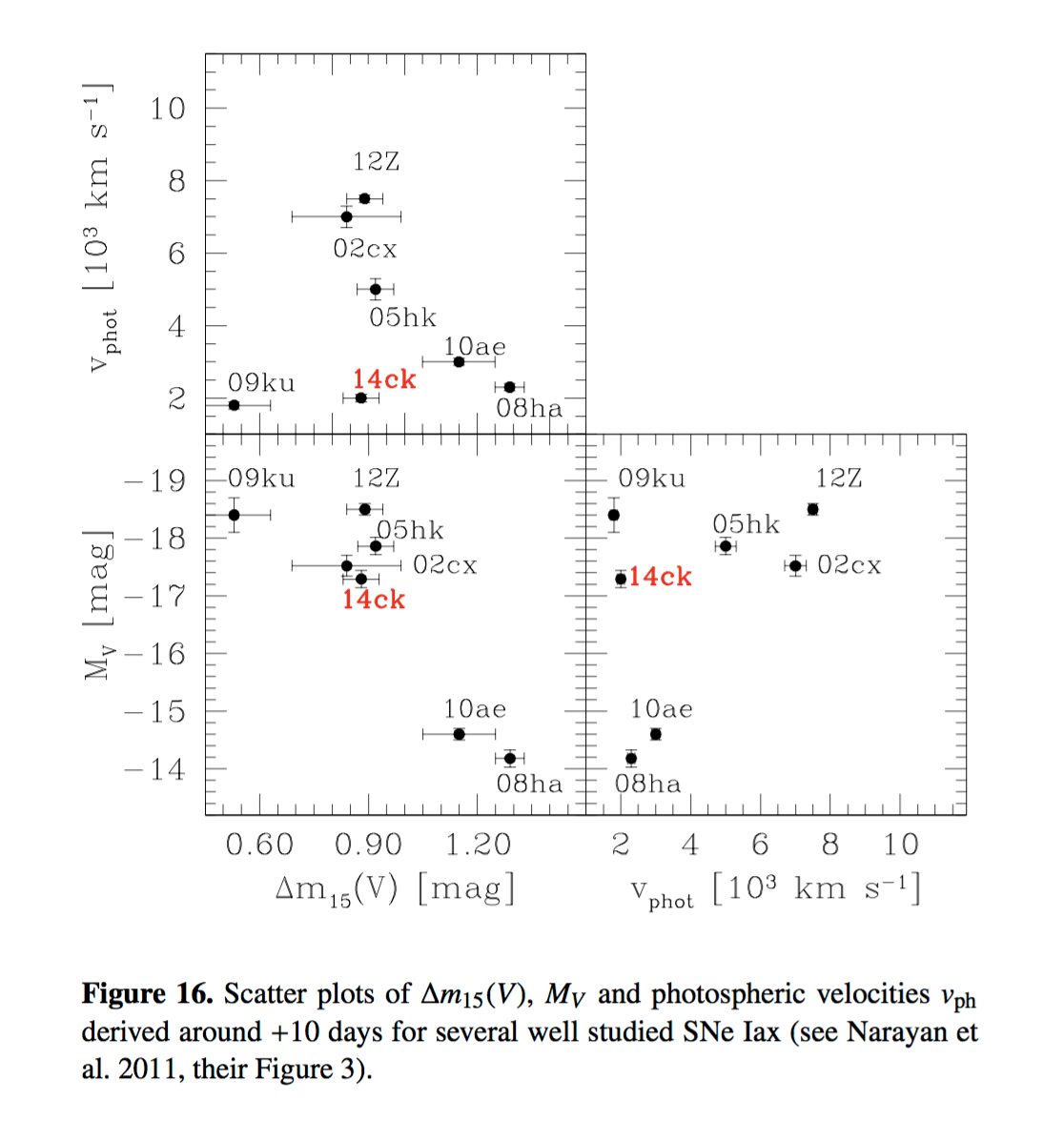Padova-Asiago Supernova Group
Highlights
Optical and near infrared observations of SN 2014ck: an outlier among the Type Iax supernovae
Tomasella, L. et al. 2016 MNRAS 459, 1018 (link to pdf)
We present a comprehensive set of optical and near-infrared photometric and spectroscopic observations for SN 2014ck, extending from pre-maximum to six months later. These data indicate that SN 2014ck is photometrically nearly identical to SN 2002cx, which is the prototype of the class of peculiar transients named SNe Iax. Similar to SN 2002cx, SN 2014ck reached a peak brightness MB=17.3+/-0.15 mag, with a post-maximum decline-rate m15(B)=1.76+/-0.15 mag. However, the spectroscopic sequence shows similarities with SN 2008ha, which was three magnitudes fainter and faster declining. In particular, SN 2014ck exhibits extremely low ejecta velocities, 3000 km s1 at maximum, which are close to the value measured for SN 2008ha and half the value inferred for SN 2002cx. The bolometric light curve of SN 2014ck is consistent with the production of 0.10+0.040.03M of 56Ni. The spectral identification of several iron-peak features, in particular Co II lines in the NIR, provides a clear link to SNe Ia. Also, the detection of narrow Si, S and C features in the pre-maximum spectra suggests a thermonuclear explosion mechanism. The late-phase spectra show a complex overlap of both permitted and forbidden Fe, Ca and Co lines. The appearance of strong [Ca~II] 7292, 7324 again mirrors the late-time spectra of SN 2008ha and SN 2002cx. The photometric resemblance to SN 2002cx and the spectral similarities to SN 2008ha highlight the peculiarity of SN 2014ck, and the complexity and heterogeneity of the SNe Iax class. 75
Tomasella, L. et al. 2016 MNRAS 459, 1018 (link to pdf)
We present a comprehensive set of optical and near-infrared photometric and spectroscopic observations for SN 2014ck, extending from pre-maximum to six months later. These data indicate that SN 2014ck is photometrically nearly identical to SN 2002cx, which is the prototype of the class of peculiar transients named SNe Iax. Similar to SN 2002cx, SN 2014ck reached a peak brightness MB=17.3+/-0.15 mag, with a post-maximum decline-rate m15(B)=1.76+/-0.15 mag. However, the spectroscopic sequence shows similarities with SN 2008ha, which was three magnitudes fainter and faster declining. In particular, SN 2014ck exhibits extremely low ejecta velocities, 3000 km s1 at maximum, which are close to the value measured for SN 2008ha and half the value inferred for SN 2002cx. The bolometric light curve of SN 2014ck is consistent with the production of 0.10+0.040.03M of 56Ni. The spectral identification of several iron-peak features, in particular Co II lines in the NIR, provides a clear link to SNe Ia. Also, the detection of narrow Si, S and C features in the pre-maximum spectra suggests a thermonuclear explosion mechanism. The late-phase spectra show a complex overlap of both permitted and forbidden Fe, Ca and Co lines. The appearance of strong [Ca~II] 7292, 7324 again mirrors the late-time spectra of SN 2008ha and SN 2002cx. The photometric resemblance to SN 2002cx and the spectral similarities to SN 2008ha highlight the peculiarity of SN 2014ck, and the complexity and heterogeneity of the SNe Iax class. 75
